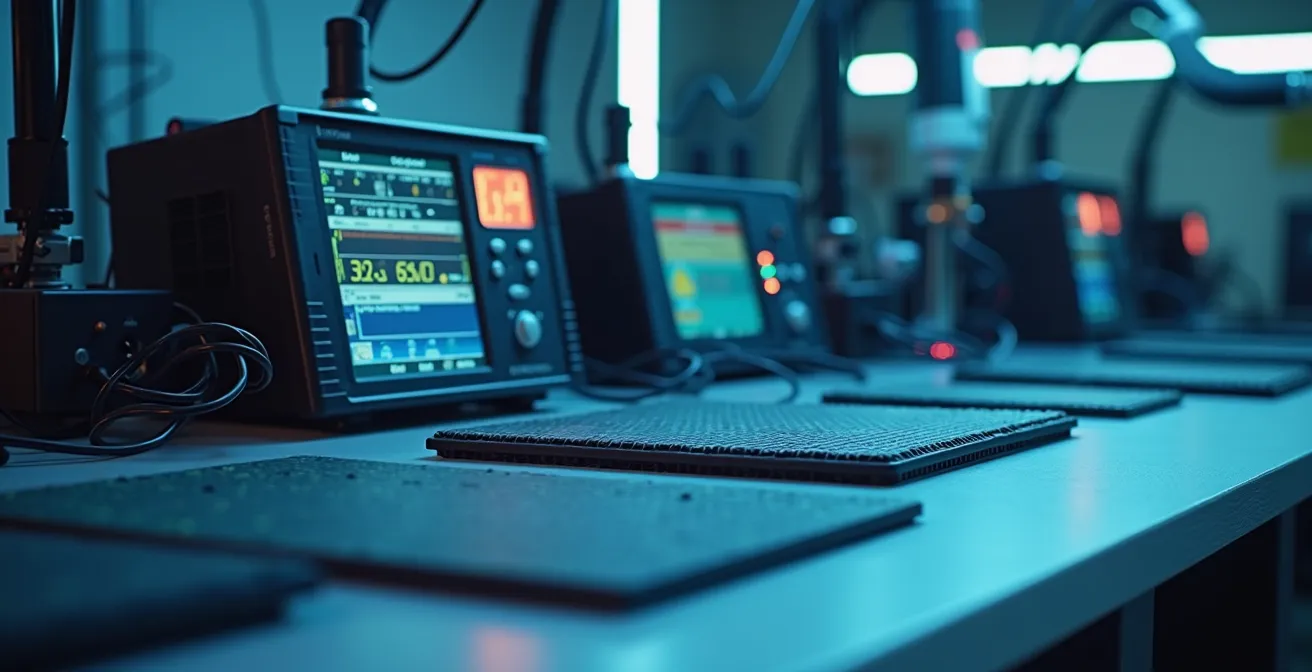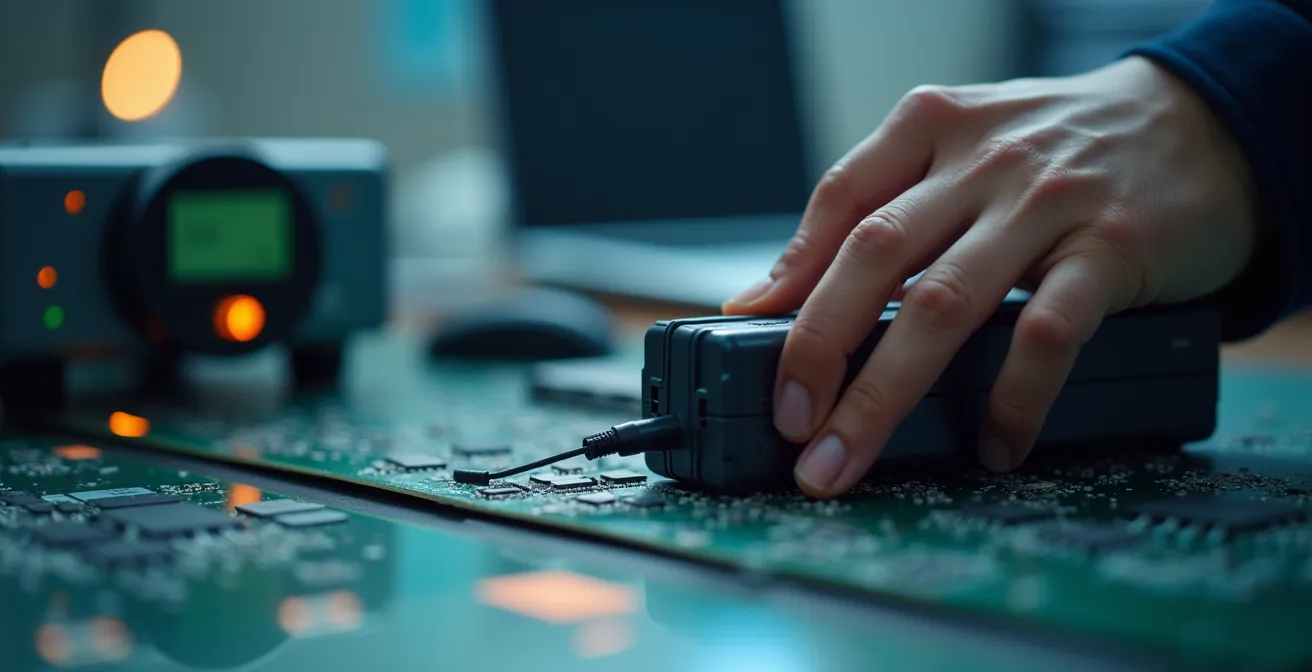
Electrostatic Discharge (ESD) is an invisible threat with tangible consequences, capable of silently destroying sensitive electronic components in an instant. While many organizations understand the need for protection, they often treat it as a static checklist of mats and wrist straps. This approach is fundamentally flawed. A truly effective strategy requires viewing the protected area not as a collection of products, but as a dynamic, human-centric ecosystem that demands continuous oversight and adaptation. This is the core of building a compliant EPA zone.
The journey to creating a resilient Electrostatic Protected Area (EPA) moves beyond mere component installation. It involves a deep understanding of material science, a commitment to fostering an ESD-aware culture, and a rigorous verification process. By focusing on the interconnectedness of these elements, you can build a protective system that not only meets compliance standards but also evolves with the increasing sensitivity of modern electronics.
Your EPA Setup Blueprint
- Go Beyond the Checklist: Treat your EPA as a dynamic ecosystem, not just a set of equipment.
- Integrate the Human Factor: An ESD-aware culture is your most critical component; training and compliance are paramount.
- Verify, Don’t Assume: Implement a continuous testing and auditing schedule to ensure ongoing effectiveness.
- Adapt and Evolve: Your EPA must adapt to new component sensitivities and evolving manufacturing processes.
Defining Your Electrostatic Protected Area: Purpose, Scope, and Foundational Principles
The first step in preventing ESD damage is formally defining the space where sensitive components will be handled. This designated area, the EPA, is the cornerstone of any effective ESD control program. Its primary purpose is to create a controlled environment where electrostatic charge can be managed safely, preventing catastrophic failures in sensitive electronics. The size and complexity of an EPA can vary dramatically, from a single benchtop workstation for a specific task to an entire manufacturing floor where every process is controlled.
An EPA is a defined space where measures are taken to prevent electrostatic charge generation and safely manage charge removal to protect sensitive devices.
– Desco Europe, What Is An ESD Protected Area (EPA)? Video
The core principles of any EPA revolve around three key actions: grounding all conductive and dissipative items, bonding them together to create an equipotential balance, and shielding sensitive devices when they are moved outside the protected area. The decision on how large or stringent an EPA needs to be is driven by identifying the most vulnerable components and processes within your workflow.
Understanding the different scales of an EPA is crucial for efficient and cost-effective implementation. A targeted approach ensures that the highest level of protection is applied where it’s needed most.
| EPA Size | Typical Use | Control Methods |
|---|---|---|
| Individual Workstation | Single operator setup | Wrist straps, mats, grounding plugs |
| Room Zone | Entire room with multiple stations | Flooring, footwear systems, ionizers |
| Facility-wide | Multiple rooms or entire plant | Comprehensive grounding, training, signage |
To establish a solid foundation, a systematic approach is necessary. Following a clear set of initial steps ensures that no critical aspect is overlooked from the outset.
Steps to Identify EPA Foundational Principles
- Identify sensitive components requiring protection.
- Define reasonable EPA boundaries and signage.
- Establish grounding and bonding protocols.
- Train personnel on EPA policies and ESD hazards.
Advanced Material Science and Environmental Controls for Superior ESD Mitigation
The physical construction of an EPA relies on a sophisticated understanding of material science. The selection of materials is not arbitrary; it’s a calculated choice based on their electrical properties and intended application. The three main categories—conductive, dissipative, and anti-static materials—each play a distinct role in safely managing electrostatic charges. Conductive materials provide a path for charge to travel to ground quickly, while dissipative materials do so more slowly and in a more controlled manner, which is often safer for sensitive devices.
What is the difference between conductive and dissipative materials?
Conductive materials have low electrical resistance (10^3 – 10^5 ohms) and drain static charge very quickly. Dissipative materials have higher resistance (10^6 – 10^9 ohms), allowing charge to drain to ground more slowly and controllably.
Choosing the right materials for workstations and flooring is a critical decision. Surface resistivity measurements are key to verifying that a material will perform as expected within the ESD control system. Beyond materials, environmental factors like humidity and temperature have a significant impact on static generation. Dry air, for instance, dramatically increases the potential for charge buildup, making humidity control an essential component of a comprehensive EPA strategy.
This table breaks down the key differences and applications for each type of ESD control material.
| Material Type | Surface Resistivity | Common Use | Limitations |
|---|---|---|---|
| Conductive | 10^3 – 10^5 ohms | Grounding paths, mats | Can conduct high currents |
| Dissipative | 10^6 – 10^9 ohms | ESD safe flooring, wrist straps | Slower discharge rate |
| Anti-static | Varies | Packaging, coatings | No direct grounding |
In environments where grounding is not possible, particularly with insulating materials that cannot drain a charge, ionizers become indispensable. These devices neutralize static charges on surfaces by flooding the air with positive and negative ions, effectively preventing charge accumulation on essential items like circuit board substrates or plastic housings.

The strategic placement of these elements creates a multi-layered defense. An optimized workstation, featuring dissipative mats connected to a common point ground, coupled with controlled ambient humidity and targeted ionization, forms a robust barrier against ESD events.
Integrating the Human Element: Training, Culture, and Proactive Compliance
An EPA is only as effective as the people working within it. Technology and materials can fail if human behavior is not aligned with ESD control principles. Therefore, creating a deeply ingrained, proactive culture of ESD awareness is arguably the most critical component of a successful program. This goes far beyond a one-time training session and requires continuous reinforcement and a genuine understanding of the risks involved.
Training must go beyond basics to foster a culture aware of ESD risks and compliance for sustained protection.
– Bondline ESD Training Expert, How to make ESD Training work for your business beyond 2022
Personnel grounding through wrist straps and appropriate footwear is the first line of defense against charges generated by human movement. These must be integrated seamlessly into daily workflows to ensure consistent use. As one report on training effectiveness suggests, staff reported greater awareness of ESD risks and behaved more consistently with grounding and handling protocols post-training. This highlights the direct link between education and compliance.
A comprehensive training program is foundational to building this culture. It must not only instruct but also explain the “why” behind the rules to foster buy-in.
Key Steps for Effective ESD Training Programs
- Explain static generation and damage mechanisms.
- Demonstrate ESD control products used in the workplace.
- Teach compliance with EPA protocols.
- Review international ESD standards such as BSEN 61340-5.
However, even with training, common pitfalls can undermine an EPA’s integrity. Addressing these human-factor challenges proactively with clear mitigation strategies is essential for maintaining a high level of compliance.
| Pitfall | Impact | Mitigation |
|---|---|---|
| Forgetting wrist strap use | ESD damage risk increased | Visual reminders, signage |
| Poor footwear grounding | Charge build-up while moving | Footwear compliance checks |
| Non-compliance with procedures | Increased product failure | Regular refresher trainings |
Verification and Evolution: Ensuring EPA Effectiveness Through Testing and Scalability
Setting up an EPA is not a one-time event; it is the beginning of a continuous cycle of verification and improvement. An EPA’s effectiveness can degrade over time due to worn-out materials, broken connections, or procedural drift. A robust compliance verification plan, built on regular testing and auditing, is the only way to ensure the system remains fully functional. The implementation of regular audits has a profound impact, with studies showing a 75% reduction in ESD incidents after audit implementation.
This process requires the right equipment. Surface resistivity meters, wrist strap testers, and static field meters are essential tools for diagnosing the health of an EPA. The data gathered from these instruments, when properly calibrated and interpreted, provides actionable insights that can prevent failures before they occur. By analyzing this data, you can significantly improve your business intelligence regarding production yields and failure analysis.
As manufacturing needs grow, the ability to scale an EPA becomes critical. Strategies for expanding from a single workstation to a multi-zone facility must be carefully planned to maintain compliance with standards like ANSI/ESD S20.20 and IEC 61340. These standards provide a framework for creating and maintaining an effective ESD control program.
Executing a verification plan requires a structured approach to ensure all elements of the EPA are functioning correctly and in compliance with industry standards.
Key Steps for EPA Testing and Compliance Verification
- Select appropriate ESD test equipment based on application needs.
- Calibrate devices regularly and interpret test results correctly.
- Document compliance checks per standards ANSI/ESD S20.20 and IEC 61340.
- Scale EPA zones carefully to maintain effectiveness across site.
Furthermore, different electronic components have varying levels of sensitivity, which are categorized into classes. Understanding these voltage thresholds is essential for designing an EPA that provides the appropriate level of protection, especially for highly sensitive Class 0 devices.
| Class | Voltage Threshold | Application |
|---|---|---|
| Class 0 | Below 250 volts | Most sensitive electronic devices |
| Class 1 | 250 – 1000 volts | General purpose electronic components |
| Class 2 | Above 1000 volts | Less sensitive electronics |
Key Takeaways
- An effective EPA is a dynamic system, not just a static setup of anti-static equipment.
- Human factors, including training and culture, are paramount for sustained compliance and protection.
- Continuous verification through regular auditing and testing is non-negotiable for ensuring EPA integrity.
- Material science and environmental controls must be tailored to the specific sensitivities of the components handled.
Troubleshooting and Continuous Improvement: Maintaining a Resilient EPA
Even the best-designed EPA can develop vulnerabilities over time. A proactive approach to troubleshooting and maintenance is essential for long-term resilience. This involves regularly searching for common setup errors, such as improper grounding or the accidental introduction of static-generating materials into the protected area. A proactive maintenance schedule for all ESD control equipment—from testing wrist straps daily to verifying the performance of flooring annually—is critical.
One of the most effective strategies for maintaining resilience is implementing a system for continuous monitoring. As noted in industry reports, continuous EPA monitoring and auditing enabled early detection of ESD risk increases, prompting timely maintenance and training refreshers. This shifts the posture from reactive problem-solving to proactive risk mitigation.
Identifying common failure points is the first step toward building a more robust system. These issues are often simple oversights that can have significant consequences.
Common EPA Setup Errors and Corrective Measures
- Incorrect grounding connections.
- Use of non-ESD compliant materials.
- Ignoring regular equipment testing schedules.
- Lack of refresher training and employee reinforcement.
The electronics industry is in a constant state of flux. As device sensitivities increase and manufacturing processes change, EPA strategies must adapt. This evolution is driven by the data collected during audits and by staying current with the latest advancements in semiconductor maintenance and handling protocols.

Ultimately, a resilient EPA is one that is built on a foundation of continuous improvement. It is a system that learns from its own performance data, adapts to new challenges, and is supported by a well-trained and vigilant workforce. This holistic approach ensures that the invisible threat of ESD remains effectively controlled, protecting valuable products and processes now and in the future.
Frequently Asked Questions on EPA Zone Setup
Why is humidity control important in an EPA?
Low humidity allows static electricity to build up much more easily. Maintaining a minimum humidity level (typically 30-40% RH) makes the air more conductive, which helps to dissipate static charges from surfaces and reduces the risk of an ESD event.
Can I use any plastic bag inside an EPA?
No, standard plastics are insulators and are significant static generators. Inside an EPA, you must only use ESD-safe packaging, such as anti-static (pink poly) bags for non-sensitive items or shielding bags for protecting sensitive components when moved outside the EPA.
How often should I test my wrist strap?
Wrist straps should be tested every day, or even at the beginning of each shift, before handling any ESD-sensitive components. Daily testing with a wrist strap tester ensures the strap and cord are functioning correctly and providing a safe path to ground.
What is the purpose of an ionizer in an EPA?
An ionizer is used to neutralize static charges on insulating materials that cannot be grounded, such as plastic component trays or circuit board substrates. It emits a balanced stream of positive and negative ions that neutralize charges on these surfaces, making the area safer for sensitive devices.